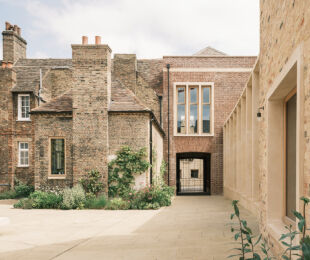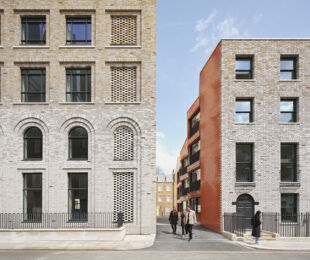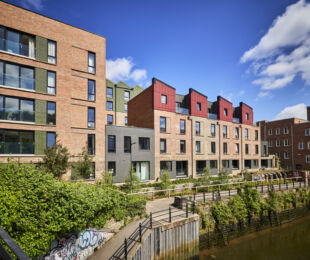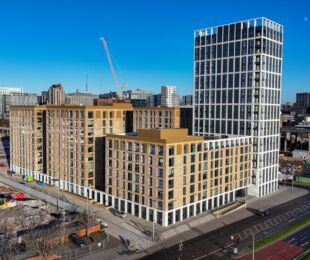
The student residences are part of the new Manor Park Campus at the University of Surrey. The crescent shaped site is lined by trees along its back edge and looks out over the campus across Daphne Jackson Road. The development fits into the University’s masterplan for the campus and was built in two phases.
Arranged around interlinked courtyards, the residences, both enclosed and open on one side, present a series of gables to the road, rather like a series of converted barns which sit comfortably in the semi-rural landscape. In this way, the design responds to the University’s aim of creating a transition between the rural and urban landscape. A varied skyline is formed by the alternating gables and lower linking blocks.
A limited palette of strong durable materials was chosen, to create architecture with collegiate character appropriate to this setting, which will weather well and minimise maintenance. In summary, stock brickwork, with deep window reveals, aluminium window frames and steeply pitched slate roofs.
Courtyard planning creates an attractive living environment which encourages community interaction, while optimising the use of the land. The courts themselves are semi-private, accessible by residents and their visitors. Stair and lift cores are typically located at the corners of the courtyards, providing access to three or four individual flats on each floor. Each staircase has a glazed entrance area with seating with reds and engineering bricks having been made by Ibstock. Each contains different types of accommodation to provide a choice of living environment. In total there are 953 student rooms.
The University earmarked the site for five storey buildings, but the top floor rooms are within the roof space and the linking buildings drop to three storeys to reduce the overall scale. Ribbon windows under the eaves visually lower the roof-line on some of the flank elevations, helping to root the buildings in the landscape.
Kitchen/dining rooms with large bay windows are located at focal points in the elevations, in the gables and over the path which links the courts.
The buildings were designed to maximise passive environmental control and minimise energy requirements, with a well-insulated envelope, high thermal mass in the brickwork envelope and structure, high air-tightness, and heat reclamation in the ventilation system. Off-site construction was used for key components and a retention pond was created to provide rainwater attenuation.






